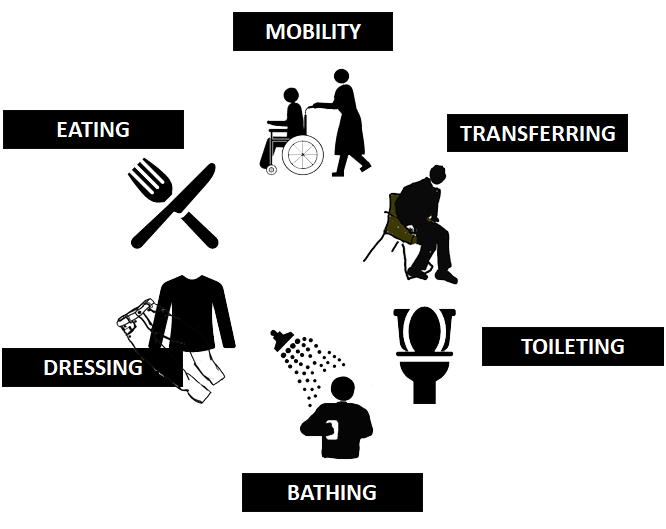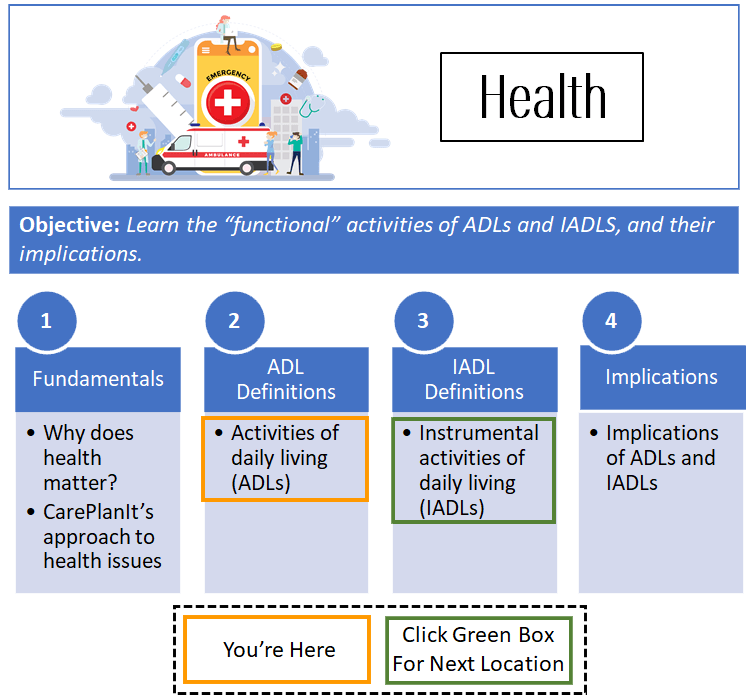Activities of Daily Living – Why They Matter
Click here to see what's on this page.
Activities of daily living (ADLs) are the criteria used to determine if seniors can function in an assisted living facility. Generally, an assisted living facility will not accept someone that can’t do most of their ADLs. If a senior wants to stay home, they’ll need others to help them with the ADL’s they cant do on their own.

Activities of Daily Living (ADLs) are:
Activities of daily living are criteria used to determine if we can function in an assisted living facility or require nursing home type care. Here’s a good video explaining ADLs.
To help better understand these areas we’ll examine some further definitions in the form of some questions often used to explore the depths
What best describes the condition of the Ager in the categories below.
Toileting
- Completely care for self at toilet; no incontinence
- Incontinent, but cares for self, using a catheter or bag completely
- Needs to be reminded, helped to clean, or has rare (weekly at most) accidents
- Soils or wets while asleep more than once a week
- Soils or wets while awake more than once a week
- No control of bowels or bladder
- Needs help with a catheter
- Needs help with a colostomy bag
Feeding
- Eats without assistance
- Eats with a little assistance at mealtimes and/or with food specially prepared and/or help cleaning up after meals
- Feeds self but requires moderate assistance and is sloppy and untidy
- Needs extensive assistance for all meals
- Uncooperative and/or combative during meals
Dressing
- Independently dresses (able to dress, undress and select clothes from wardrobe)
- Needs minor assistance to dress and undress
- Needs moderate assistance in dress, undress, and choose clothes
- Needs major assistance to dress and undress, but is cooperative with helpers
- Unable to dress and undress and is cooperative with only specific helpers and caregivers
- Unable to dress and undress and is uncooperative with all helpers and caregivers
Grooming ADLs
- Always neatly dressed, well-groomed, no assistance required
- Needs minor assistance to adequately groom (e.g., shave)
- Needs moderate assistance, but does not require constant monitoring
- Needs moderate assistance and requires constant monitoring
- Needs major assistance, but with help can stay well-groomed
- Is uncooperative and sometimes combative with all helpers and caregivers
Mobility
- Capable of walking around the house, mall or city (fully mobile)
- Can walk the residence, including stairs, and a few hundred feet (can get mail)
- Can walk for only short distances and needs help getting in & out of chairs and climbing stairs
- Requires the assistance of a cane, walker or wheelchair to get around
- Able to sit unsupported in chair or wheelchair, but cannot transfer out of the chair or move the wheelchair without help
- Is essentially bedridden (in bed more than half the time)
Bathing
- Independently able to bathe (e.g., bath, shower, etc.)
- Bathes self, but needs help transferring in and out of the tub or shower
- Washes face and hands only, but cannot bathe rest of body
- Needs major assistance to wash and bathe but is cooperative with helpers and caregivers
- Unable to stay clean and is uncooperative and sometimes combative with all helpers and caregivers
Evaluating ADLs
The fewer activities of daily living a senior can perform, the more help they need. You can use our ADL Work Sheet in our Premium Content to assess your abilities or a loved ones. See an example here. Or you can use the information above to create your own.
